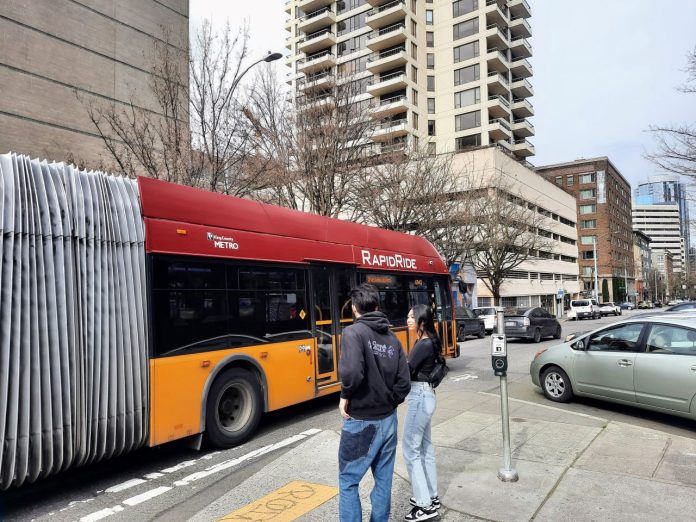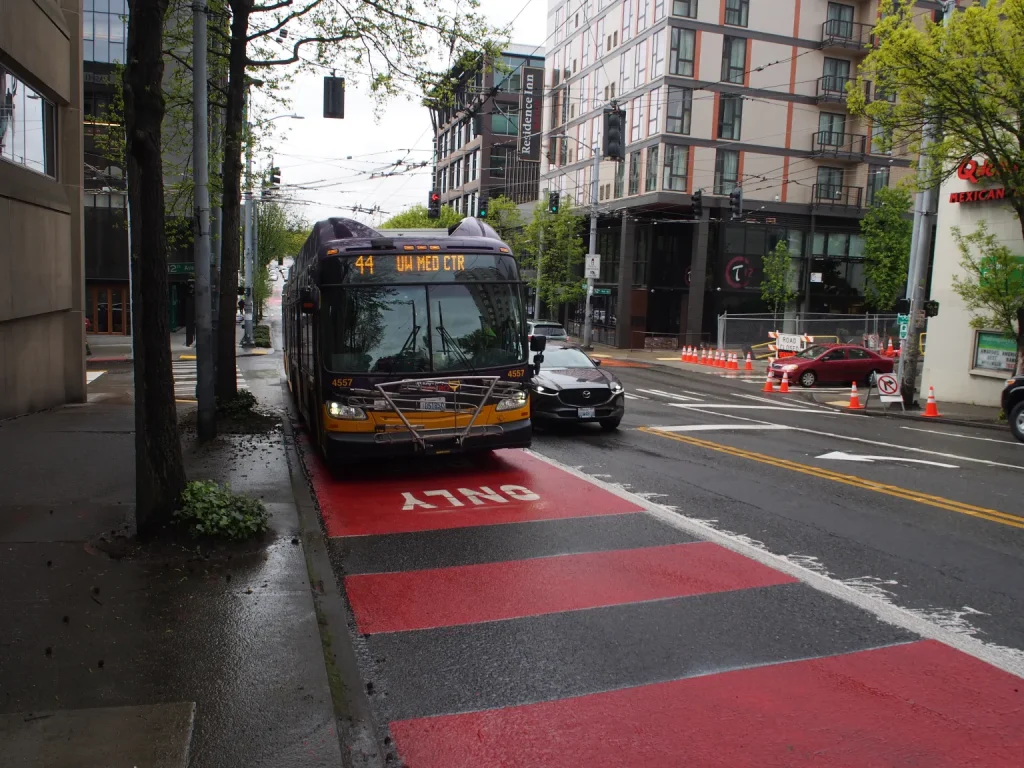
Transit is at a crossroads. The pandemic upended a period of growing ridership and service that saw Seattle lead the nation in both the rate of ridership gains and car-free household formation. It also disrupted King County’s plans to run a transit funding measure in 2020. The countywide proposal has remained shelved ever since and transit service levels have languished.
In the three intervening years, local leaders have managed decline or pivoted to other goals like electrifying the bus fleet instead of taking concerted efforts to get transit service expanding once more in the near-term. That neglect needs to stop. County Councils around the region must invest in their transit agencies so that bus service can return to pre-pandemic service levels and growth trends. In King County’s case, this could mean resurrecting the countywide transportation benefit district it was considering in 2020.
A jump in work-from-home measures has smoothed out demand at peak times, which actually makes it easier for transit agencies to manage their service. Instead of spiking for the work commute and disappearing, demand has remained steady all day. More folks are turning to transit for errands or meeting friends instead of riding for the slog to work and little else. Of course, there’s also people who have fallen out of the habit of riding transit entirely and need sufficiently reliable service to coax them back into it.
This presents a great opportunity if policymakers are smart enough to seize it. Boosting service and increasing frequencies midday, evenings, and weekends would attract more ridership and convince more people to think of transit as a viable option at all hours instead of only for the brief peak periods when agencies jack up frequencies.
The ridership that disappeared during the pandemic was not uniform. High-income workers are more likely to telework, while lower wage workers are likely still obligated to work on-site. This has big implications for transit. In fact, Commute Seattle’s recent survey showed a reversal in the income of the average transit rider. “People who live in households that make below $90,000 are more likely to take transit than those who make over $90,000, a reversal from pre-pandemic.”
That reversal involved a hollowing out of ridership: “Respondents with Center City workplaces shared that they used public transit 22% of the time in 2022, up slightly from 18% in 2021, but lower than the 46% in 2019,” Commute Seattle wrote. This mirrors King County Metro data, which shows transit ridership today is about half of what it was in 2019.
The ideal transit network would serve everybody. Transit agencies need to increase frequencies both to serve “transit-dependent” populations that continue to rely on their system and to attract “choice” riders who have other options. These folks may have a car in the garage or the disposable income to pay for ridehailing trips but would take transit if it was convenient and reliable enough.
Former mayor of Bogotá Enrique Peñalosa — now a globetrotting urban planning consultant — radically transformed his city’s streets to support a world class bus rapid transit network and prioritize people walking, rolling, and biking. “An advanced city is not one where the poor can get around by car, but one where even the rich use public transportation,” Peñalosa famously said.
Una ciudad avanzada no es en la que los pobres pueden moverse en carro, sino una en la que incluso los ricos utilizan el transporte público.
Former mayor of Bogotá Enrique Peñalosa
English translation: An advanced city is not one where the poor can get around by car, but one where even the rich use public transportation.
The Puget Sound Region is not going to achieve such a vision of egalitarian transportation if it continues to treat bus service as an afterthought or a ‘nice to have’ instead of essential basic service that its climate, environmental justice, economic equality, and equity goals are riding on. We don’t just need more service hours, we also need bus lanes and transit priority that ensures buses aren’t stuck in traffic gridlock.
Illustrating the point this month is a bus restructure proposal to go along with the rollout of the RapidRide G Line on Seattle’s Madison Street in late 2024. As Ryan Packer laid out, the G and neighboring lines will see anemic evening and weekend service despite the route running through a major nightlife district and the region’s main hospital cluster. Both generate demand at all hours. With not enough hours to go around, the G restructure means worse service on many nearby bus routes. Restructures for new rapid routes should be additive rather than austerity in disguise.

Light rail expansion will be a nice backbone for the network, but buses will continue to be the essential workhorses of the system. A spate of delays for light rail projects means they’ll have to carry the load unassisted for longer than anticipated. The need to curb climate emissions as soon as possible means waiting for light rail expansion to boost transit ridership isn’t a tenable climate strategy. Poor service also saps support for transit and trust that new projects will deliver.
A three-year delay to the Tacoma Dome Link Extension prompted the Pierce County Council to write to Sound Transit to ask for additional service to mitigate the delay. Their letter asks for:
- Increasing opportunities for people to use Sounder commuter rail, including more daily runs, an extension to DuPont as quickly as possible, and better, safer station access.
- Expanding Sound Transit express-bus services and frequency between Pierce County and King County.
Increasing service on bus and commuter rail lines that riders are already relying on is low-hanging fruit that really must be harvested in order to get some transit momentum building in our region again and make life a little easier for people relying on transit to get around.
Talk boosting transit service tonight with fellow advocates at a 6pm to 8pm social hour at Optimism Brewing.
Doug Trumm is publisher of The Urbanist. An Urbanist writer since 2015, he dreams of pedestrian streets, bus lanes, and a mass-timber building spree to end our housing crisis. He graduated from the Evans School of Public Policy and Governance at the University of Washington in 2019. He lives in Seattle's Fremont neighborhood and loves to explore the city by foot and by bike.

